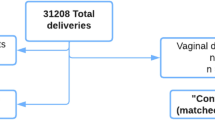Abstract
Uterine rupture complicates approximately 1% of trials of labor after cesarean. Classic signs and symptoms include loss of station, cessation of labor, vaginal bleeding, fetal distress, and abdominal pain. Other signs are also possible. We report a case of uterine rupture at VBAC trial that includes an unusual clinical sign of uterine rupture: vernix caseosa observed in the urine of the parturient. During labor, a bladder catheter was inserted to evaluate oliguria. Vernix caseosa and blood were found in the tubing. Prompt cesarean delivery followed. A tear extending from the original transverse scar into the bladder dome was found. Vernixuria is an additional sign of uterine rupture.
This is a preview of subscription content, access via your institution
Access options
Subscribe to this journal
Receive 12 print issues and online access
$259.00 per year
only $21.58 per issue
Buy this article
- Purchase on Springer Link
- Instant access to full article PDF
Prices may be subject to local taxes which are calculated during checkout
Similar content being viewed by others
References
Rageth JC, Juzi C, Grossenbacher H . Delivery after previous cesarean: A risk evaluation. Obstet Gynecol 1999;93:332–337.
Flamm BL, Goings JR, Liu Y, Wolde-Tsadik G . Elective repeat cesarean delivery versus trial of labor: A prospective multicenter study. Obstet Gynecol 1994;83:927–932.
Yap SOW, Kim ES, Laros RK . Maternal and neonatal outcomes after uterine rupture in labor. Am J Obstet Gynecol 2001;184:1576–1581.
Zelop CM, Shipp TD, Repke JT, Cohen A, Caughey AB, Lieberman E . Uterine rupture during induced and augmented labor in gravid women with one prior cesarean delivery. Am J Obstet Gynecol 1999;181:882–886.
Phelan JP . Uterine rupture. Clin Obstet Gynecol 1990;33:432–437.
Plauche WC, Von Almen W, Muller R . Catastrophic uterine rupture. Obstet Gynecol 1984;64:792–797.
Hibbard JU, Ismail MA, Wang Y, Te C, Karrison T, Ismail MA . Failed vaginal birth after a cesarean section: How risky is it? I. Maternal morbidity. Am J Obstet Gynecol 2001;184:1365–1373.
Narendran V, Wickett RR, Pickens WL, Hoath SB . Interaction between pulmonary surfactant and vernix: a potential mechanism for induction of amniotic fluid turbidity. Pediatr Res 2000;48:120–124.
Author information
Authors and Affiliations
Additional information
During a VBAC trial, vernix caseosa and blood were observed in Foley catheter drainage. At laparotomy, a uterine rupture extended into the bladder.
Rights and permissions
About this article
Cite this article
O'Grady, J., Prefontaine, M. & Hoffman, D. Vernixuria: Another Sign of Uterine Rupture. J Perinatol 23, 351–352 (2003). https://doi.org/10.1038/sj.jp.7210897
Published:
Issue Date:
DOI: https://doi.org/10.1038/sj.jp.7210897



